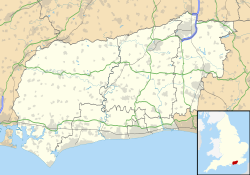Before 1946
There is mention of Gossipsgreen on a map dated 1795. Maps in the first half of the 1800s show Gossipsgreen in varying layouts surrounded by farmland and close to a few small estates. Gossipsgreen amounted to a hamlet along the north side of what is now known as Gossops Green Lane. The main road ran east–west through the settlement. At the west end the road turned north towards the village of Ifield passing The Craigans, a house with gardens which was demolished and developed as private housing in the 1970s. To the east the road ran to Crawley through what is now Goffs Park and West Green.
A road led south from Gossipsgreen approximately along what is now Dower Walk, past Dower House and Woldhurstlee estate and on towards Buxwood (later Buckswood) Farm. Woldhurstlee was demolished during the New Town development. The site of the house is now in public woodland off Buckswood Drive.
The railway was built in the 1830s to the north of Gossipsgreen and ran by Hazelwood, a wooded area behind the hamlet, then past The Craigans before dividing Ifield Mill Pond to the west. Ifield railway station was first a halt on the road leading from Gossipsgreen to Ifield.
During Victorian times, Gossipsgreen disappeared from published maps, though The Craigans, Dower House and Woldhurstlee continued to be marked. By 1946, a year before the formation of the Crawley Development Corporation, the hamlet reappeared on the map but the name had changed to Gossops Green.
1946 and After
Crawley Development Corporation was formed in 1947 as a result of the New Towns Act 1946. At this time, Crawley had a population of 6,000 people. It was a declared objective that the New Town would be home to 50,000 people by 1961. It had achieved this by 1958 before Gossops Green was built.
According to A History of the County of Sussex (1987, Hudson et al., online), the new neighbourhood of Gossops Green was ninth and last of the original New Town communities laid out during 1956-7 and built between 1958 and 1961. Later developments include The Holy Trinity School (1967), Hillmead and Parkhurst Close (formerly The Craigans) and private housing between The Holy Trinity School and Buckswood Drive (1970-80s).
The old road into Ifield was reconstructed as an extension to Ifield Drive leading into another new neighbourhood of Ifield over a manually operated railway crossing similar to that still found down the line at Littlehaven railway station. The road name was changed to Craigans (after the adjacent, demolished house of the same name) after the construction of a road bridge over the railway at Overdene Drive, following which the railway crossing was closed.

